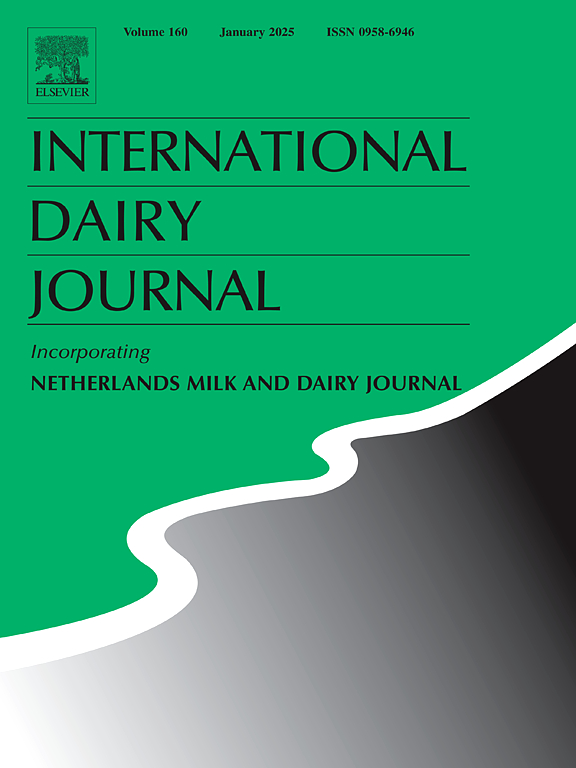The effect of season, somatic cell count and bulk milk storage time on the sensory and chemical characteristics of an aged hard goat milk cheese
IF 3.1
3区 农林科学
Q2 FOOD SCIENCE & TECHNOLOGY
引用次数: 0
Abstract
This study investigated the impact of seasonality (lactation stage), milk storage time and somatic cell count (SCC) on the chemical ripening and sensory characteristics of hard goat milk cheese ripened for 12–18 months. Milk was collected from four farms at four stages: indoor feeding (A), mountain pasture release (B), high summer pasture (C), and lowland pasture during oestrus (D). Cheeses were produced the following- and three days after delivery. Quantitative Descriptive Analysis (QDA) revealed significant seasonal differences in sensory attributes. Cheeses from season C and D exhibited more ‘sweet taste’ and ‘caramel flavour’, while those from season A had more ‘oxidized odour’ and ‘acidic taste’. Season C and D cheeses had higher levels of total free amino acids (FAA), and a stickier, more cohesive texture compared to the drier, grittier texture of season A cheeses. The results indicate that season and bulk milk storage time have a greater effect on cheese sensory and chemical properties than SCC, although SCC did have an impact. Developing production protocols that consider seasonal variation (lactation stage) and SCC, is essential to optimise cheese quality standardisation, benefiting small-scale artisanal and industrial goat cheese producers.
季节、体细胞数和散装乳贮存时间对陈化硬羊奶干酪感官和化学特性的影响
本试验研究了季节(哺乳期)、乳储存时间和体细胞计数对成熟12-18个月的硬羊奶奶酪化学成熟和感官特性的影响。牛奶从四个农场分四个阶段采集:室内饲养(A)、山地牧场放养(B)、夏季高地牧场放养(C)和发情期的低地牧场放养(D)。奶酪在产后和产后三天生产。定量描述分析(QDA)揭示了感官属性的显著季节性差异。产自C和D季节的奶酪表现出更多的“甜味”和“焦糖味”,而产自A季节的奶酪则表现出更多的“氧化味”和“酸味”。季节C和D奶酪的总游离氨基酸(FAA)含量更高,与季节a奶酪的干燥、粗糙的质地相比,它们的质地更粘、更有凝聚力。结果表明,季节和散装牛奶的储存时间比SCC对奶酪的感官和化学性质有更大的影响,尽管SCC确实有影响。制定考虑季节变化(哺乳期)和SCC的生产方案对于优化奶酪质量标准化至关重要,这有利于小规模手工和工业山羊奶酪生产商。
本文章由计算机程序翻译,如有差异,请以英文原文为准。
求助全文
约1分钟内获得全文
求助全文
来源期刊

International Dairy Journal
工程技术-食品科技
CiteScore
6.50
自引率
9.70%
发文量
200
审稿时长
49 days
期刊介绍:
The International Dairy Journal publishes significant advancements in dairy science and technology in the form of research articles and critical reviews that are of relevance to the broader international dairy community. Within this scope, research on the science and technology of milk and dairy products and the nutritional and health aspects of dairy foods are included; the journal pays particular attention to applied research and its interface with the dairy industry.
The journal''s coverage includes the following, where directly applicable to dairy science and technology:
• Chemistry and physico-chemical properties of milk constituents
• Microbiology, food safety, enzymology, biotechnology
• Processing and engineering
• Emulsion science, food structure, and texture
• Raw material quality and effect on relevant products
• Flavour and off-flavour development
• Technological functionality and applications of dairy ingredients
• Sensory and consumer sciences
• Nutrition and substantiation of human health implications of milk components or dairy products
International Dairy Journal does not publish papers related to milk production, animal health and other aspects of on-farm milk production unless there is a clear relationship to dairy technology, human health or final product quality.
 求助内容:
求助内容: 应助结果提醒方式:
应助结果提醒方式:


